Featured Science
The UNDP records India’s rapid strides in improving rates of under- and malnutrition. Their records show that between 2006 and 2016, stunting in children below five years declined from 48 to 38%. However, India’s efforts to improve its nutritional status continue through involving science and technology for attaining self sufficiency in food.
Following international recommendations, India has adopted sustainable development goals as a member state of United Nations calling for universal action to end poverty, protect the planet and ensure peace and prosperity of all people by 2030. The Union Ministry of Agriculture and Farmers Welfare report claims that country has witnessed record food grains production of 277.49 million tons, oilseeds and sugarcane production of 29.88 and 353.23 million tons, respectively, in 2017-18. Furthermore, India has emerged as world’s largest milk producer and the second largest producer of fruits and vegetables
This huge increase in food production possibly will help India to eradicate the instances of stunting among children, under- and mal nutrition among women, children and lactating mothers, and guarantee every citizen’s access to adequate food round the year through sustainable food systems. India is also working hard to meet the target of doubling of small land holder’s productivity and income, and reduced the food losses. So far, the country has been dealing with food insecurity through the National Food Security Act (NFSA) passed in 2013. Several programmes and schemes are being implemented by government of India to ensure food availability and security.
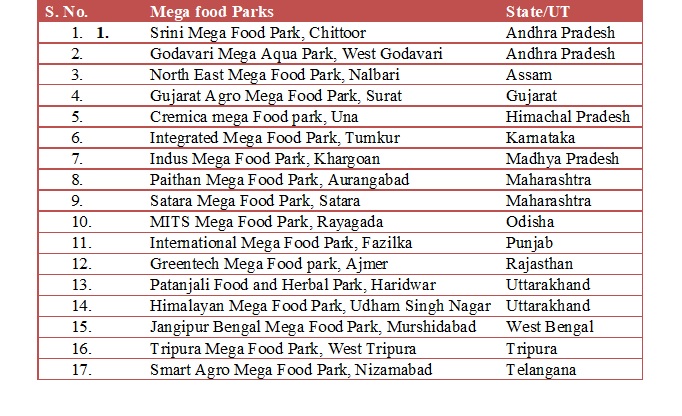
System of Mega Food Parks: The Mega Food Park were set up with an aim to provide a mechanism to link agricultural production to the market by bringing together farmers, people involved in food processing and retailers so as to increase value addition, reduce wastage, improve farmers income and to create employment opportunities predominantly rural agricultural practices. So far government has established 17 Mega Food Parks which are functional (Table 1). Such food parks are based on “Cluster” approach and it visualizes making of state of art support infrastructure in a well-defined agri- and horticultural zone for setting up of modern food processing units in the industrial plots. Schemes promotes expansion of agribusiness in mega food parks with well established supply chain infrastructure including collection centers, primary processing centers, central processing centers, cold chain and around the food processing units. Such setups ensure availability of right food choices at affordable rates in market.
Development of Food Processing Industry: The Ministry of Food Processing Industries have extended financial assistance to research & development work to benefit the food processing industry in terms of product and process development, efficient technologies- and packaging material development, value addition and standardization of additives, colouring agents, preservatives, pesticide residues, chemical- and microbial contaminants and naturally occurring toxic substances within permissible limits. It has been established that a vibrant food processing play a vital role in reducing the wastage of perishable food items and improving the shelf life of food products, ascertain the diversification, value addition and commercialization of agricultural products. Such financial assistance also targets employment generation, and increasing farmer’s income.
Food Processing Start-Ups: India has made huge strides in global startup community, and ranks amongst the top five countries in the world in terms of number of startups founded. India houses about 4200 start ups which have created creating more than 85,000 employment opportunities. Furthermore, it has been predicted that the number of start-ups will increase to over 11,500 by 2020 in India and the number of jobs may reach to 2.5-3.0 lakhs. Food processing start ups have emerged as a result increase in consumption of processed foods. Processed foods are considered as healthy, safe, hygienic and convenience driven foods. Food start-ups are offering healthy, value added, and safe food products. Broad functional areas and activities of food start ups are classified into the following eight categories (Fig. 1).
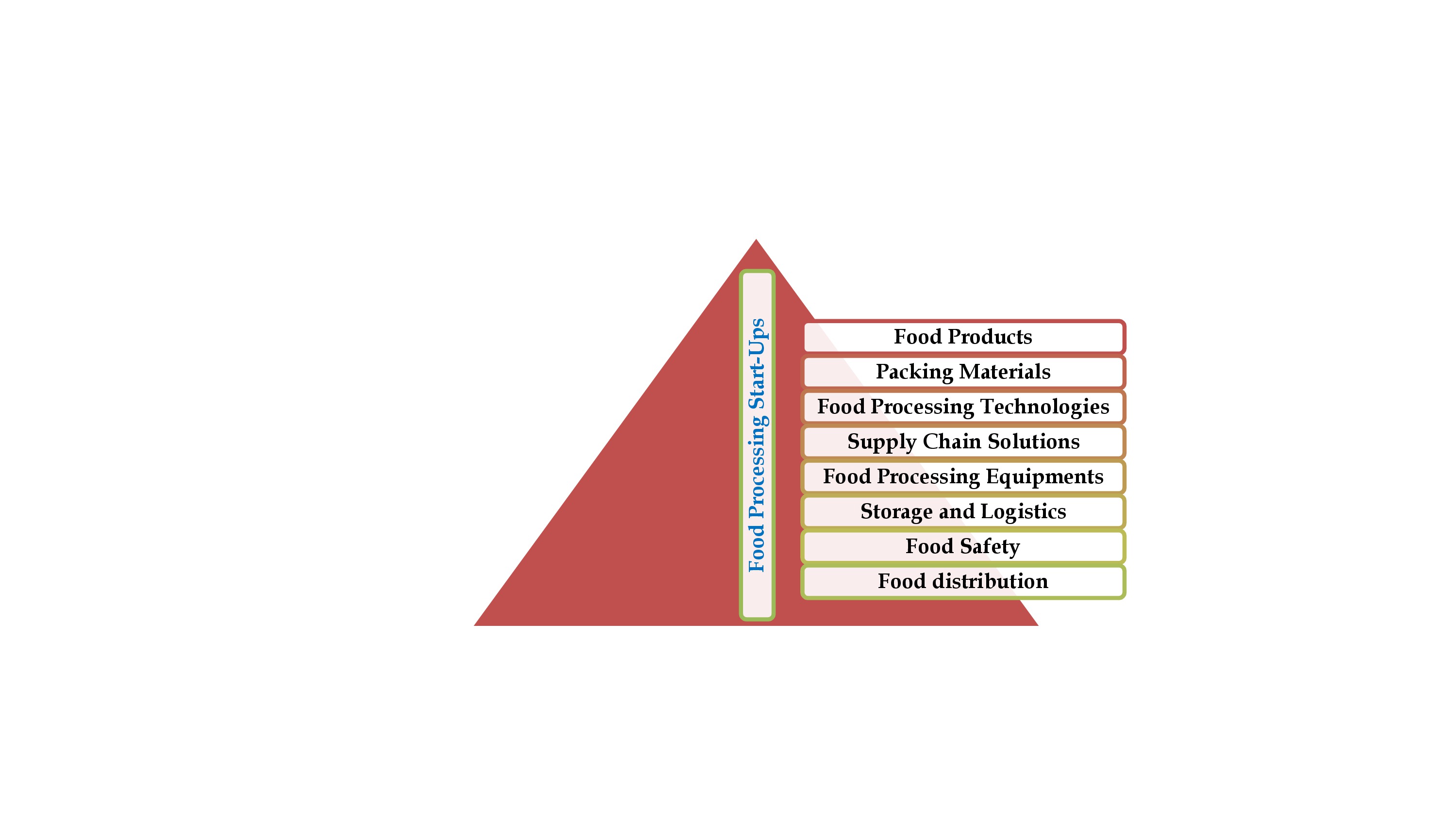
Development of Knowledge-based Food Products/Technologies: The Council of Scientific and Industrial Research (CSIR) is functioning with 11 dedicated research laboratories involved in R&D research related to food technologies and processes development. Over the years, CSIR has developed numerous novel food processing technologies/processes which have been successfully commercialized1. Some of the key developments made by CSIR in this direction include:
- Development of improved technologies for storage and preservation
- Development of traditional and health-, specialty-, and ready-to-serve foods, nutraceuticals, beverages, etc.
- Scaling-up and improvement of food processing technology.
- Food product value addition, food safety and byproducts/wastes utilization.
- Food processing machinery/equipment development.
- Development of eco-friendly packaging materials and environment-friendly processes.
- Biotechnological intervention for enhancing nutritional values.
Some of the major foods/drinks, food processing technologies and knowledge-based products developed by CSIR are enlisted below in Table 2.
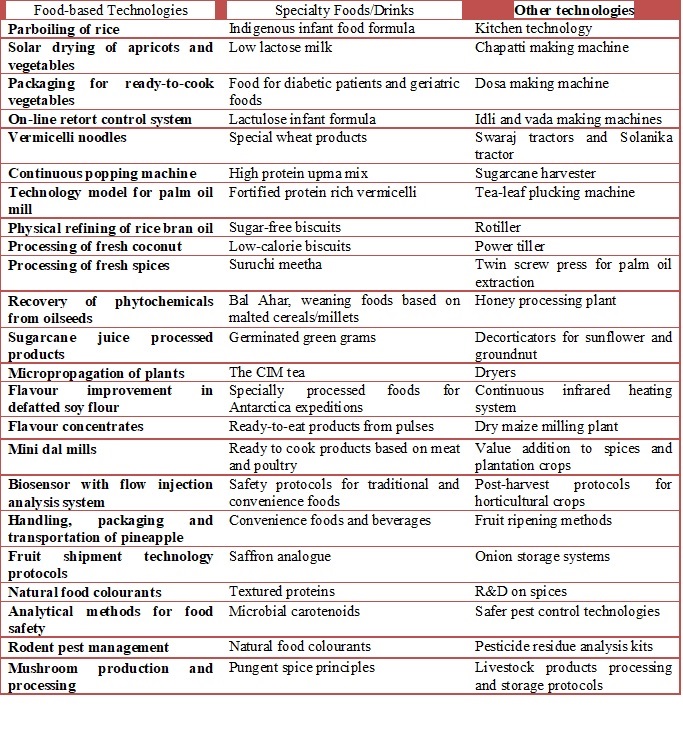
Progress of Indian agricultural research: The Indian Council of Agricultural Research (ICAR) is an apex research organization of India with a high standing amongst international agricultural research institutions. The council plans, coordinates- and promotes research and technology development for sustainable agriculture in the country. The ICAR has 101 research institutes and 71 agricultural universities spread across the country which has been at forefront in pioneering Green Revolution and subsequent developments in agriculture sciences. The R&D activities of these research institutes has made it possible for India to develop technology and knowledge that has enabled the country to increase the production of food grains by 5.4 times, horticultural crops by 10.1 times, fish by 15.2 times, milk 9.7 times and eggs 48.1 times till 2017. The research and development has evident impact on food and nutritional security of country2.
Government of India has introduced multiple schemes and programmes to ensure availability of food. Some of the important initiatives taken are National Rural Health Mission (NRHM), Janani Suraksha Yojana (JSY), Mid Day Meals (MDM), Indra Gandhi Matritva Sahyog Yojana (IGMSY), Kishori Shakti Yojana (KSY), and National Rural Drinking Water Programme (NRDWP) etc., to address food security and associated problems.
The POSHAN Abhiyaan: The POSHAN Abhiyaan or National Nutrition Mission is Government of India’s flagship programme aimed at improving nutritional requirements of children, pregnant women and lactating mothers. The programme intends to fulfill country commitment towards eliminating under- and mal-nutrition among children, pregnant women and lactating mothers in three years after its launch in 2018. The POSHAN Abhiyaan mission’s broad theme includes antenatal care, optimal breastfeeding, complementary feeding, anaemia, growth monitoring, education and marriage of girls, diet, hygiene and sanitation, and most specially importance of right choice foods and their impact on health. Total number of districts covered (to be covered) under three phases of POSHAN Abhiyaan mission from 38 States/Union Territories during 2017-20 are represented by figure 2.
The Government of India has undertaken multiple reforms to meet nutrition- and food availability targets. Some of the multiple multidimensional ambitious schemes aimed at addressing the inequalities related to food availability-, nutrition and food security are discussed as:
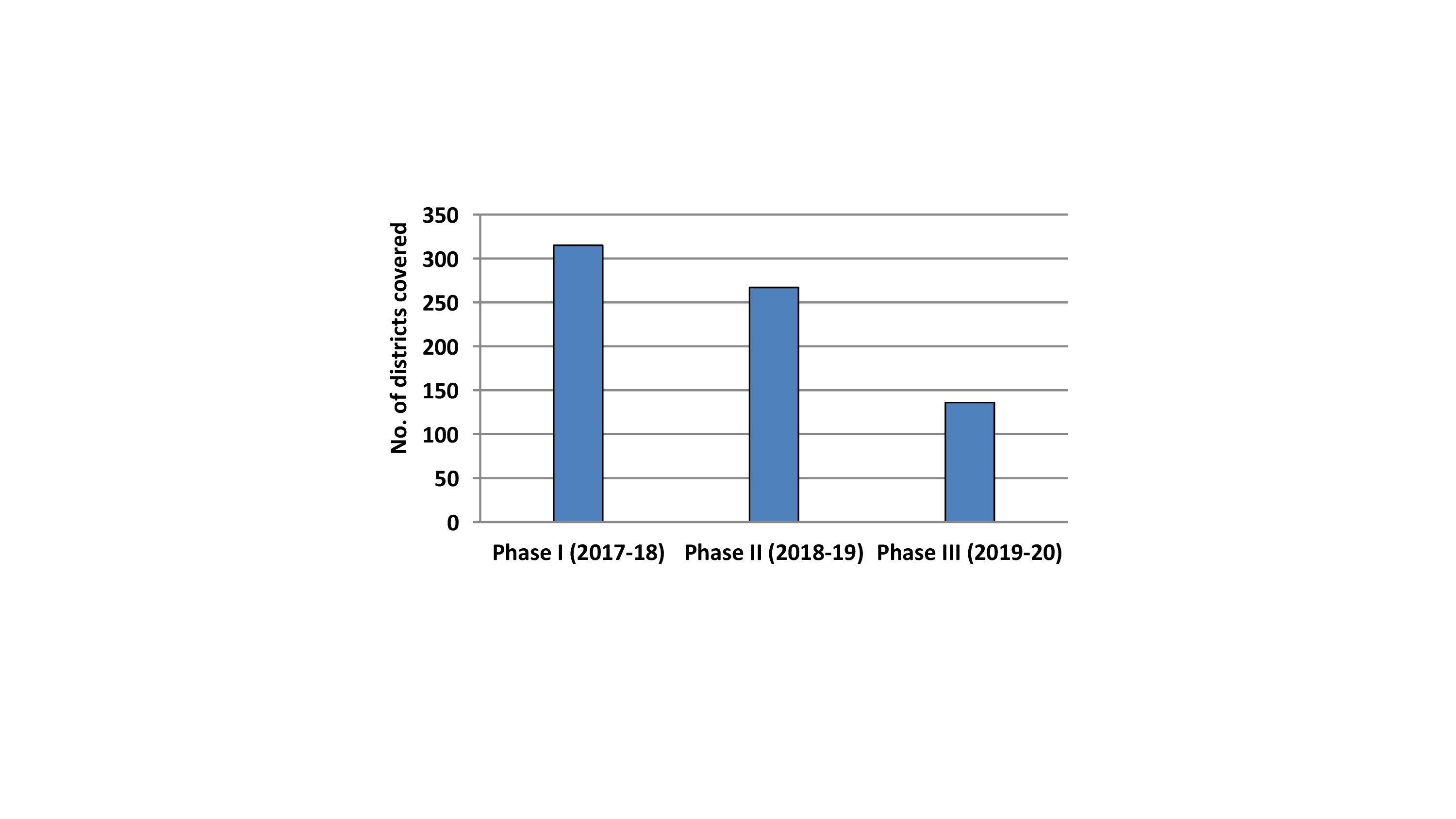
The Green Revolution, India: Green Revolution of 1965 helped India to attain surplus food production with introduction of high yielding variety of seeds, fertilizers and agro-chemicals, new cultivation methods, use of modern technology coupled with controlled and efficient irrigation system. India moved on from traditional farming towards commercial farming and attained the remarkable results in terms of agricultural production. Although India has progressed entirely on several health outcomes, however, more sustainable efforts are required to attain food security and to overcome the under- and malnutrition.
National Food Security Mission (NFSM): To ensure availability of food to every Indian, the National Development Council (NDC) launched NFSM in 2007 to increase the annual production of rice by 10 million tonnes, wheat by 8 million tonnes and pulses by 2 million tonnes by the end of the 11th five year plan. The mission met with a huge success and achieved the targeted additional production and the mission continued during 12th plan with new targets of additional production of 25 million tonnes of food grains comprising of 10 million tonnes rice, 8 million tonnes of wheat, 4 million tonnes of pulses and 3 million tonnes of coarse cereals.
Mid Day Meal Scheme (MDMS): The Ministry of Human Resource Development (MHRD) launched MDMS in 2001. Under the scheme, the every child studying in every government and government aided primary school gets a mid day meal containing a minimum content of 300 calories of energy and 8-12 grams of protein per day for a minimum of 200 days and in 2006, the nutritional norm were revised to 450 calories and 12 gram of protein. In 2002, the MDMS was extended to children studying in Education Guarantee Scheme (EGS) and Alternative & Innovative Education (AIE) centres. In 2004, scheme was revised to provide for central assistance for cooking cost of Re 1 per child per school day to cover cost of pulses, vegetables cooking oil, condiments, fuel and cook wages.
In 2004 transport subsidy was raised and a provision for serving mid day meal was made possible during summer vacation in drought affected areas. In 2006, kitchen-cum-store construction and procurement of kitchen devices, a central assistance of rupees 60,000 per unit and rupees 5,000 per school, respectively, was given in a phase manner. The scheme was further extended to cover children of upper primary classes (class VI-VIII) studying in 3,479 Educationally Backwards Blocks (EBBs). Thus, in 2007 the scheme was renamed as to ‘National Programme of Mid Day Meal in Schools’ and the nutritional norm for upper primary stage was fixed at 700 calories and 20 grams of protein. It was further introduced to unrecognized institutions like Madarsas/Maqtabs supported under Sarva Shiksha Abhiyan.
Pradhan Mantri Matru Vandana Yojana: In 2016, the Ministry of Women and Child Development, Government of India implemented Pradhan Mantri Matru Vandana Yojana (PMMVY), which was previously known as Indira Gandhi Matritva Sahyog Yojana (IGMSY). The maternity benefit program aims at providing cash incentive of rupees 5000 to pregnant women and lactating mothers for the first living child of the family for fulfilling the specific maternal and child health needs. It is part of rupees 6000 compensation given on an average to the woman and the remaining one thousand is provided under Janani Suraksha Yojana (JSY) after institutional delivery.
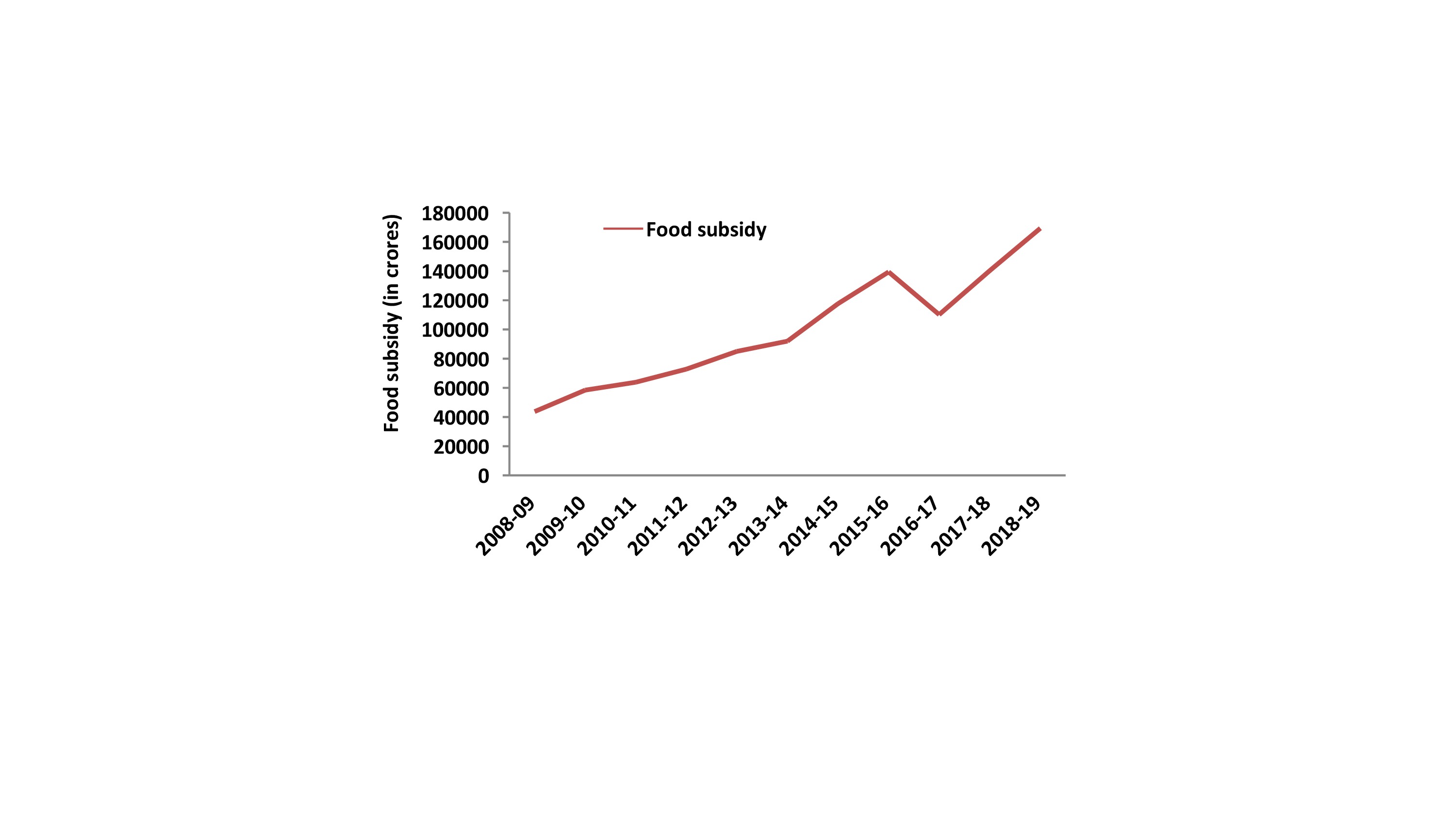
Public Distribution System (PDS): The Department of Food and Public Distribution (DFPD) is responsible for ensuring food security through procurement, storage and distribution of food grains in India. The Food Corporation of India (FCI) also shoulders some of the responsibilities The PDS system was renamed as Targeted Public Distribution System (TPDS) to remove the lope holes in the system. Under TPDS system, food grains were providing to people below the poverty line at highly subsidized rates. The National Food Security Act, 2013 mandates to cover 75% of the population from rural areas and 50% from urban areas, and currently covers 81 crore people. Government has shown consistent increase in allocation of food subsidies (in crore) to the DFPD3 (Fig. 2).
Another flagship programme in direction of promotes healthy food choices launched by Government of India in 2018 was called as 'Swasth Bharat Yatra'. Under this programme, a pan-India cycle rally was organized to sensitize people about eating safe food and be healthy and the cyclathon was supported by the Food Safety and Standards Authority of India (FSSAI). The programme also encouraged combating food adulteration.
More to the point, Mahatma Gandhi National Rural Employment Guarantee Act (MNREGA), a social employment guarantee act is one of the most influential initiatives undertaken for transformation of economy of rural households in India. The MNREGA Act was enacted in 2005 to provide a minimum guaranteed wages for 100 days in financial year to every rural household with unemployed unskilled adult. As per reports the increment in incomes of rural households generated through MNREGA works has enabled them to purchase adequate foods and other consumables. Thus, MNREGA had improved the food security of some households and saved some households from worsening their food security.
The importance of the food security can be understood from the fact more than one third of the world’s malnourished children are in India and India ranks 102th among 117 countries in Global Hunger Index, 20194. However, introduction of several social benefitting programmes and schemes has enabling India to manage malnutrition among pregnant- and lactating women, and children.
References:
- https://www.csir.res.in/achivement/csir-pride/food-food-processing.
- https://icar.org.in/content/about-us.
- Demand for Grants 2018-19 Analysis: Food and Public Distribution (https://www.prsindia.org/parliamenttrack/budgets/demand-grants-2018-19-a...).
- Hunger, Nutritional Challenges and India’s Dismal Ranking on Global Hunger Index (https://www.youthkiawaaz.com/2019/10/hunger-pangs-nutritional-challenges-and-indias-dismal-ranking-on-global-hunger-index/).
Dr. Bilqeesa Bhat, Ph.D
Project Scientist Vigyan Prasar,
Department of Science and Technology (DST),
New Delhi, India
bhat.bilqeesa3000@gmail.com